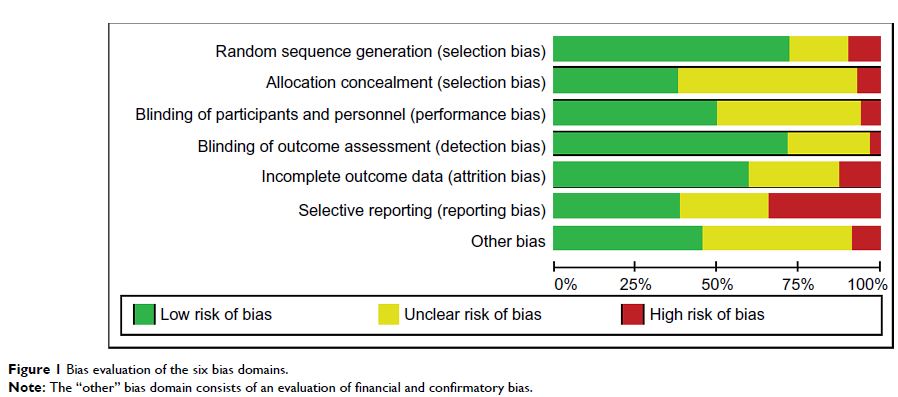9 7 8 1 6
论文已发表
注册即可获取德孚的最新动态
IF 收录期刊
- 3.3 Breast Cancer (Dove Med Press)
- 3.4 Clin Epidemiol
- 2.5 Cancer Manag Res
- 2.9 Infect Drug Resist
- 3.5 Clin Interv Aging
- 4.7 Drug Des Dev Ther
- 2.7 Int J Chronic Obstr
- 6.6 Int J Nanomed
- 2.5 Int J Women's Health
- 2.5 Neuropsych Dis Treat
- 2.7 OncoTargets Ther
- 2.0 Patient Prefer Adher
- 2.3 Ther Clin Risk Manag
- 2.5 J Pain Res
- 2.8 Diabet Metab Synd Ob
- 2.8 Psychol Res Behav Ma
- 3.0 Nat Sci Sleep
- 1.8 Pharmgenomics Pers Med
- 2.7 Risk Manag Healthc Policy
- 4.2 J Inflamm Res
- 2.1 Int J Gen Med
- 4.2 J Hepatocell Carcinoma
- 3.7 J Asthma Allergy
- 1.9 Clin Cosmet Investig Dermatol
- 2.7 J Multidiscip Healthc

已发表论文
Dose-related beneficial and harmful effects of gabapentin in postoperative pain management – post hoc analyses from a systematic review with meta-analyses and trial sequential analyses
Authors Fabritius ML, Wetterslev J, Mathiesen O, Dahl JB
Received 31 March 2017
Accepted for publication 1 July 2017
Published 1 November 2017 Volume 2017:10 Pages 2547—2563
DOI https://doi.org/10.2147/JPR.S138519
Checked for plagiarism Yes
Review by Single-blind
Peer reviewers approved by Dr Colin Mak
Peer reviewer comments 2
Editor who approved publication: Dr E. Alfonso Romero-Sandoval
Background: During the last
15 years, gabapentin has become an established component of postoperative pain
treatment. Gabapentin has been employed in a wide range of doses, but little is
known about the optimal dose, providing the best balance between benefit and
harm. This systematic review with meta-analyses aimed to explore the beneficial
and harmful effects of various doses of gabapentin administered to surgical
patients.
Materials and methods: Data in this paper were derived from an original review, and the subgroup analyses were predefined in an International Prospective Register of Systematic Reviews published protocol: PROSPERO (ID: CRD42013006538). The methods followed Cochrane guidelines. The Cochrane Library’s CENTRAL, PubMed, EMBASE, Science Citation Index Expanded, Google Scholar, and FDA database were searched for relevant trials. Randomized clinical trials comparing gabapentin versus placebo were included. Four different dose intervals were investigated: 0–350, 351–700, 701–1050, and >1050 mg. Primary co-outcomes were 24-hour morphine consumption and serious adverse events (SAEs), with emphasis put on trials with low risk of bias.
Results: One hundred and twenty-two randomized clinical trials, with 8466 patients, were included. Sixteen were overall low risk of bias. No consistent increase in morphine-sparing effect was observed with increasing doses of gabapentin from the trials with low risk of bias. Analyzing all trials, the smallest and the highest dose subgroups demonstrated numerically the most prominent reduction in morphine consumption. Twenty-seven trials reported 72 SAEs, of which 83% were reported in the >1050 mg subgroup. No systematic increase in SAEs was observed with increasing doses of gabapentin.
Conclusion: Data were sparse, and the small number of trials with low risk of bias is a major limitation for firm conclusions. Taking these limitations into account, we were not able to demonstrate a clear relationship between the dosage of gabapentin and opioid-sparing or harmful effects. These subgroup analyses are exploratory and hypothesis-generating for future trialists.
Keywords: gabapentin, 1-(aminomethyl)cyclohexaneacetic acid, analgesic, postoperative pain management, dose effect
Materials and methods: Data in this paper were derived from an original review, and the subgroup analyses were predefined in an International Prospective Register of Systematic Reviews published protocol: PROSPERO (ID: CRD42013006538). The methods followed Cochrane guidelines. The Cochrane Library’s CENTRAL, PubMed, EMBASE, Science Citation Index Expanded, Google Scholar, and FDA database were searched for relevant trials. Randomized clinical trials comparing gabapentin versus placebo were included. Four different dose intervals were investigated: 0–350, 351–700, 701–1050, and >1050 mg. Primary co-outcomes were 24-hour morphine consumption and serious adverse events (SAEs), with emphasis put on trials with low risk of bias.
Results: One hundred and twenty-two randomized clinical trials, with 8466 patients, were included. Sixteen were overall low risk of bias. No consistent increase in morphine-sparing effect was observed with increasing doses of gabapentin from the trials with low risk of bias. Analyzing all trials, the smallest and the highest dose subgroups demonstrated numerically the most prominent reduction in morphine consumption. Twenty-seven trials reported 72 SAEs, of which 83% were reported in the >1050 mg subgroup. No systematic increase in SAEs was observed with increasing doses of gabapentin.
Conclusion: Data were sparse, and the small number of trials with low risk of bias is a major limitation for firm conclusions. Taking these limitations into account, we were not able to demonstrate a clear relationship between the dosage of gabapentin and opioid-sparing or harmful effects. These subgroup analyses are exploratory and hypothesis-generating for future trialists.
Keywords: gabapentin, 1-(aminomethyl)cyclohexaneacetic acid, analgesic, postoperative pain management, dose effect
